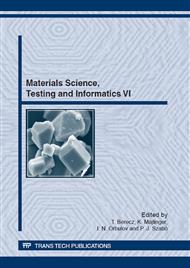p.397
p.403
p.409
p.415
p.419
p.424
p.430
p.436
p.442
Evaluation of XRD Analysis of Amorphous Alloys
Abstract:
There is an active research work in the field of amorphous alloys since the discovery of metallic glasses, half a century ago [. In contrast with crystalline alloys, amorphous one have unique material properties, e.g. high yield strength, superior elastic limit, high corrosion resistance, unique acoustical properties [2,. Producing amorphous alloys, it is first necessary to quantify the forming of structure and define the amorphous amount. All of the methods to determine the structure have advantages and disadvantages. An accurate determination of amorphous volume fraction can be accomplished by transmission electron microscopy (TEM), this observation is much localized [ and the evaluation is difficult. The most common techniques to determine the amorphous fraction are XRD and DSC methods, which reflect the entire sample [. However, XRD has a detection limit depending on the type of equipment. Apart from this fact, it is an admitted method in researches, if the XRD reflexion shows an amorphous halo. Amorphous fraction transformed to crystalline can be measured by DSC. This method is much sensitive to impurities, especially oxygen, which can influence on the results.
Info:
Periodical:
Pages:
419-423
Citation:
Online since:
November 2012
Authors:
Keywords:
Price:
Сopyright:
© 2013 Trans Tech Publications Ltd. All Rights Reserved
Share:
Citation:


